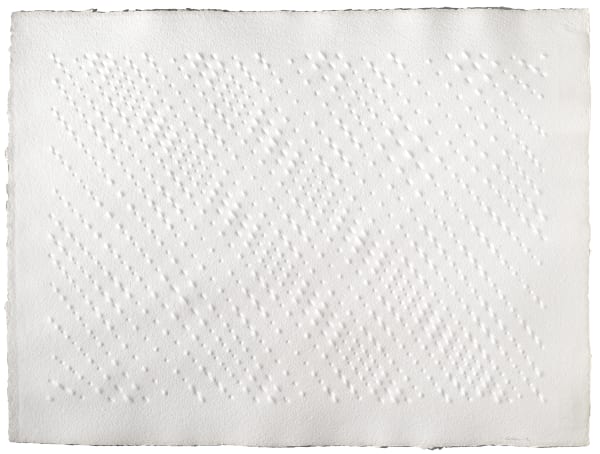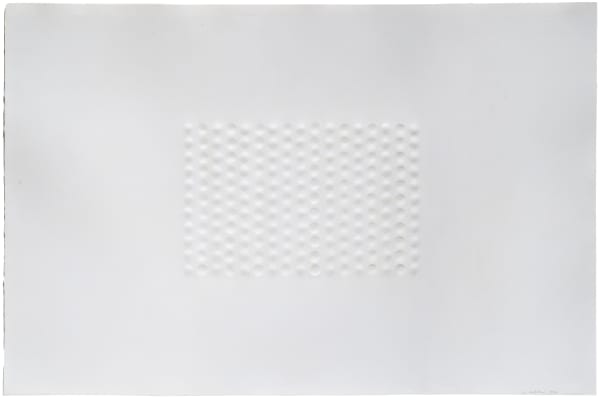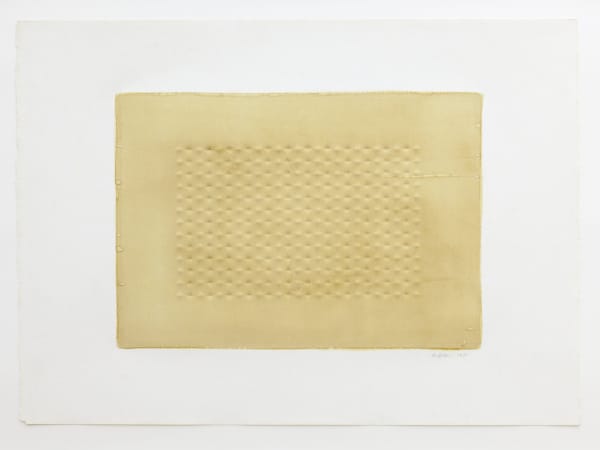Enrico Castellani: Works on paper
As with all great artists in search of their own expressive style the beginnings coincide with a sequence of stimuli, inspirations and categorical refusals.
His years of artistic formation took place in Brussels. In 1952, the artist studied painting and sculpture at the Académie Royale des Beaux-Arts and in 1956 he graduated in Architecture at the École Nationale Supérieure. In the mind’s eye, Mondrian and De Stijl never failed to impress. With his abstract representation of the surfaces in space according to well-calculated plastic relationships, the tension between straight lines and corners, the equivalence of the subjective and the objective, his painting assumed architectural forms, thus becoming an element of spatial rhythm. The neo-plastic experiments of the architect, Van Doesburg, the volumetric axonometries of his buildings, developed with intersections of geometric shapes on several levels, were present in the cultural formation of the young Castellani. In Milan, the intellectual environment was very lively and Lucio Fontana was the representative of the artistic revolution that was the very essence of all artistic research. The need for a more international breadth as well as his studies forced upon Castellani a new conception of art and the need to bring it forward with exhibitions in galleries and with articles in the magazine Azimuth with Piero Manzoni. Let us not forget that for several years the artist worked in the studio of the architect Buzzi, whose wife lent him the room on the street in Via Cernaia 4 where he opened the gallery Azimut with Piero Manzoni). The need to update the artistic panorama in Italy and to overcome the Informal was pressing and the direction he took had a very well-cut out direction.
The second and last issue of Azimuth, in January 1960, opened with a contribution by Castellani as a proponent of an art that was entirely new: “The possibility is that of an art that is continuously ongoing yet potential to the extent that its use is both swift, constant and immediate, able to create dialogues outside an intimistic monologue […] beyond the confines of myopic subjectivism. The need for the Absolute that animates us, offering us new themes, prohibits us from receiving those means that are considered to be part and parcel of pictorial language, showing little interest in expressing subjective reactions in facts or feelings but desiring our discourse to be continuous and total”.
The supersession of traditional painting, the conflict against everything that painting implied, from the use of paintbrushes to the presence of the frame, were as necessary as the search for
Enrico Castellani, Continuità e Nuovo, in “Azimuth 2”, Milan January 1960 an objective art against the exasperated expression of the Id of the artist, against any sort of decorative Intimism. Castellani has s remained faithful to these canons of a new art and in fact soon arrived at his own line of research to perfect – although also be faithful to – over the years.
His production of paper works has accompanied his entire career, running parallel to the annulling of the subjective datum on the canvas.













